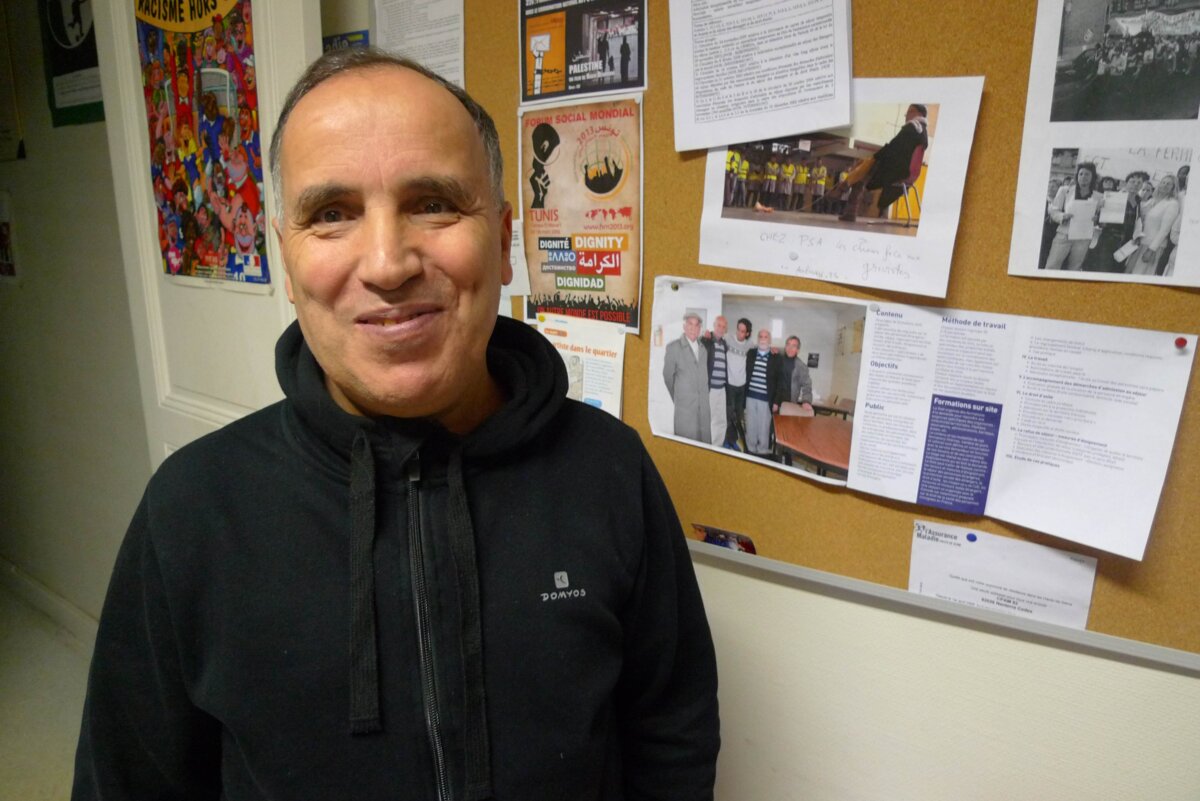The arrival in Paris on December 3rd 1983 of the March for Equality and Against Racism drew an estimated 100,000 people onto the streets to greet the weary marchers, escorting them along the capital's boulevards to a triumphant demonstration at the Place de la Bastille.
In the six weeks since the marchers had set off amid relative disinterest, from the southern city of Marseille on October 15th, their protest movement had grown into a national cause, attracting political support and widespread media coverage.
It became dubbed as ‘The march of the beurs', (La Marche des beurs), after the colloquial name (a play on the word Arab) for young French citizens born to immigrant parents from France’s former North African colonies of Algeria, Morocco and Tunisia. The march, organised by young beurs with the support of Catholic and Protestant clergymen, followed a series of violent events that highlighted the social exclusion of this new generation locked in a no-man’s land between two cultures.
That year there had notably been a series of racist murders and, during the hot summer, violent clashes between police and rioting youths in a sprawling, run-down housing estate in the suburbs of Lyon, called Les Minguettes, typical of many others around France with a large population of North African origin and where unemployment is typically higher than the national average.
It was in the aftermath of those riots at Les Minguettes that the march was organised, amid a tense political climate; in local elections , the far-right Front National party was making its first significant gains, while the then-socialist government mounted a vigorous attack on strikes in support of equal rights by immigrant manual workers at a Renault car-making plant, denouncing them as led by Islamists who threatened national interests. In a newspaper interview, the prime minister at the time, Pierre Mauroy, said the strikers were “agitated by religious and political groups” which held values that “had little in common with French social realities”.
Abdallah Moubine, who grew up in the Moroccan mining town of Khouribga, was 29 years old when the March for Equality and Against Racism took place. He was then a manual worker at a Citroën factory near Paris, and was an active trades union official.
“We saw them leave Marseille, they were just a few,” he recalls of the 1983 march. “On arrival in Paris, there were thousands of them. At our end, with our mates, we relayed [the movement], we held meetings at the Bourse du travail [trades unions’ administrative and meeting hall], debates with the sociologist Saïd Bouamama, and we took part in the demonstration on the last day in Montparnasse. It was magnificent.”

Enlargement : Illustration 1

He describes himself as being of “the generation before”, that of those who have work, unlike so many of their children, the beurs. Now almost 60, he continues to work for the French carmaker, PSA Peugeot-Citroën, doing night shifts at the same plant where he began his first job in France, in Saint-Ouen, a suburb north-west of the capital. He looks after the supplies of metal rolls for the cutting machines, working from 9.20 p.m. to 6.30 a.m., Monday to Friday. Last year he earned a total salary of 34,000 euros.
He says that today he has “neither hope nor illusion” in the current socialist government and vividly remembers how he felt targeted by the comments in 1983 of Prime Minister Mauroy aimed at the Renault strikers. At the time, North African immigrants made up the majority of the unskilled workforce in the many car-making plants situated around Paris. Moubine’s experiences, both as a North African immigrant and a union activist, provide a gritty insight into the explosive atmosphere during which the 1983 march took place.
He can remember exactly the day he arrived in France: “It was Tuesday September 4th 1973.” He had come from Morocco with the promise of a job at Citroën, found for him by his father who was already in France. “On the Wednesday, I was at a medical check-up at [the quai] Javel, in Paris, in the 15th arrondissement, where the [Citroën] head office was, and on the Thursday I was at work,” he says.
“It was me who wanted to come, my father wasn’t keen,” recalls Moubine. “For me, France was equality, fraternity, the country of human rights. It was a country where life was good.” He began at Citroën at the lowest rank. “My role was simply cutting up metal to make car parts, I pulled and I pushed, all day long, full stop, that’s it,” he explains.
After a short while, he was promoted to the post of factory store manager. “It was better,” he says. “I had to prepare the orders. That required knowing the [different] parts, the references, looking after the arrival and the sending of parts, and the reception.” His pay was modest. “If I remember well, it was 1,200 francs [about 183 euros] per fortnight. We were paid in cash, hand to hand. The chief arrived with the envelope and the pay slip. You had to say thank you.”
After a brief period with another Citroën factory north of Paris, he returned to the Saint-Ouen plant in 1980 when he joined the communist-led CGT union and which, he says, led the management to move his job. “They didn’t want me to work as a store manager anymore, which was a job that involved contact with staff, because they sensed that I had begun to be a union activist,” he says. “I found myself out on the strip loading and unloading lorries with a Fenwick [fork-lift truck], not seeing anyone anymore.”
In early 1982, he became a CGT representative on the works council. Between 1982 and 1984, Citroën and its PSA sister company Talbot, now defunct, were rocked by a series of strikes involving mostly immigrant manual workers, supported by the CGT, whose principle demands included equality of pay and promotion opportunities, better health care management, better recognition of industrial accidents, and an end to racist behaviour at the workplace.
In February 1982, Moubine joined a protest meeting at Citroën’s plant at Aulnay, north of Paris, taking the microphone to address a crowd of some 3,000. Shortly afterwards he was on the picket lines during a strike at the carmaker’s plants of Saint-Ouen, Asnières and Levallois. “I slept several nights there, in front of the factory,” he recalls.
He says his activism led to him being threatened with the sack by his managers. However, he kept his job, although he was never further promoted. He remembers a warning from his father: “’You’ll see’ he told me, ‘the bosses are all the same, in every country’. After a few months, I understood, whether it be in Morocco, France or elsewhere, you must demand things, be militant. You mustn’t stay with your arms folded.”
In 1983, Moubine went to Poissy, west of Paris, to join strikers at the plant of Citroën’s other sister company Peugeot. He recalls hearing managers and members of the company’s own staff union, the CSL, shouting “The Arabs for the oven, the Arabs in the Seine”.
“They blocked us inside a workshop, building number 3 or 5 – I can’t remember now,” he says. “We needed reinforcements from our mates to be let out. That was when there was that well-known declaration by [the then-French Prime Minister] Pierre Mauroy saying that the strikers were led, manipulated, by the Islamists.”
One of the factors in the government’s claims that the strikers were led by Islamists was that, while their demands were centred on pay and working conditions, they also included the demand for the right to a room for prayers.
Moubine, who describes himself as “a non-practicing believer”, rejects the allegations. “There weren’t Islamists in the workshop, that’s false,” he says. “I understood straight away that it was a tactic to divide the workforce and to break the relationship between [the employees of] Renault, Simca and Citroën.”
The demand for prayer rooms was also controversial for some CGT union organizers. “At that time I went regularly to [the union’s headquarters in] Montreuil,” says Moubine. “The secretary for the metal workers was called André Sainjon, he was a socialist. He was well-dressed. I used to call him ‘Mr. Minister’. He, for example, didn’t understand that demand.”
'Today, I feel trapped'
In the early 1980s, the climate of racial hatred against North Africans appeared to reach a peak of violence. There were a series of murders of people of North African origin in 1983, the year of the March for Equality and Against Racism, which the interior ministry numbered at five, while anti-racism groups identified a total of 21. One of the most notorious, and which took place at the time of the march, was the stabbing on a train of a young Algerian man who was attacked by three men travelling to a Foreign Legion recruitment test. The victim died after he was thrown out of the moving train.
Others included the shooting of a young boy in a Paris suburb. “I remember the case of Toufik, the youngster from [the Paris suburb of] La Corneuve, killed by a neighbour,” says Toubine. “That shook us up, it made us worry for the future of our children. I had just become married, and I said to myself if people are capable of using their rifle to kill youngsters, we’ve got a problem.”
He believes that the rise in racist behaviour was directly linked to France’s economic woes. “With the [economic] crisis, citizens began having no confidence in the future,” he observes. “Some latched onto the vocabulary of hate and lies that the [far-right party] FN was putting about.”
“For as long as we were invisible, while we lived in shanties, while we did the difficult jobs in the car industry and the building trade, everything was fine. But when they saw our children grow up and demand things like everyone else, that’s where it started getting messy.” Moubine underlines this change, when previously immigrant men workers had lived largely alone in France with their families remaining in their native countries. “With the reuniting of [immigrant] families, they didn’t look on us anymore like workers ready to roll their sleeves up, but as guys who were bringing over their wives who couldn’t integrate, and their children who had difficulties learning at school.”
He recalls that in the factory, he was labeled as “a red” but also as a “dirty Arab” by some. “They said that to humiliate us,” he says. “We could see in the way they spoke to us that they were racist, they considered us like less-than-nothings, like second class workers. The pressure was constant, they had no respect.”
“Most of them were former parachutists from [the war in] Algeria, and Morocco. They were ex-servicemen, former colonial settlers, they spoke a bit of Arab, they knew the Arab world a little, they’d lived there a bit. The used to say to us: ‘Ah, I know your country, you walk barefoot, you don’t even have electricity, fatma this, fatma that’.”
“At the canteen, they talk to you about pork. If you don’t drink a Ricard [traditional French aniseed alcoholic drink] you’re looked upon badly. During the Ramadan [Muslim fasting period] you get provoked, you’re told ‘come and eat’. During the [Muslim] Eid festival you’re criticized for cutting sheeps’ throats. Things like that, all the time, it’s tiring.”
In that context, he and his colleagues saw the 1983 march as a taking up of a relay in a long and bitter struggle. “Those youngsters were born in France," he underlines. "Unlike us, they had no work. Their demands were mostly about issues of integration. Their energy encouraged us. We looked upon them as our children. The marchers fought against racism, we were fighting for equality in the factories.”
Moubine believes that while today the racism against North Africans at the workplace is less frontal and blunt, but that it is nevertheless just as present. “In the factory, they don’t say ‘dirty Arab’ anymore, but they call up the Maghrebis one by one to propose they take early retirement, whereas that should be a procedure one personally decides [to ask for]. They want to get rid of us.”
Moubine says “everything that has been obtained was done so following our fights”, citing improved pay in the car industry, following the 1982-84 strikes, and the lengthening of residency and work permits for North African immigrants to ten years, a measure introduced in the wake of the 1983 march. But he laments what he calls “the lack of courage” of the current government, and notably its dithering over the granting of the right to vote in local elections for non-EU nationals resident in France.
He says he fears for the future of his four daughters: “The eldest has found a job with the [French railways company] SNCF. That’s good, but she says that the youngsters like her are mistreated at the Gare du Nord [Paris railway station], that they’re badly paid and that the rotten jobs are given to them, not the others. When she was at university, I understood; the [elite] higher education schools are not for us. My 14 year-old girl is in [secondary school] third grade. I have just submitted her request for [French] nationality. She never stops telling me that she’s had enough of being considered as an immigrant.”
“We know that we’ll never get there,” he continues. “For my daughters, [what represents] Morocco is the beach. But is France their country? At the National Assembly, in the Senate, in government, at the head of corporations, there are neither Maghrebis nor Africans. Or, when there are any, they’re background actors.”
“On the one hand, I am always looked upon as a foreigner by the [white] French. Whether I practice [religion] or not, whether I drink or not, whether I eat pork or not, it’s all the same, I will never really be one of them. On the other hand, there’s pressure from those around you. One of my daughters asked me why I didn’t pray. At the factory now, if you have a drink you’re frowned upon. I am not against having a glass of red wine or a Ricard from time to time. I do that with my French friends, not with the Muslims. Before, I didn’t take part in the Ramadan. We made up about 40 Maghrebis who didn’t do it, we used to go to the factory self-service, it passed off without any problem. Now, that wouldn’t be possible. I feel trapped.”
-------------------------
English version by Graham Tearse


